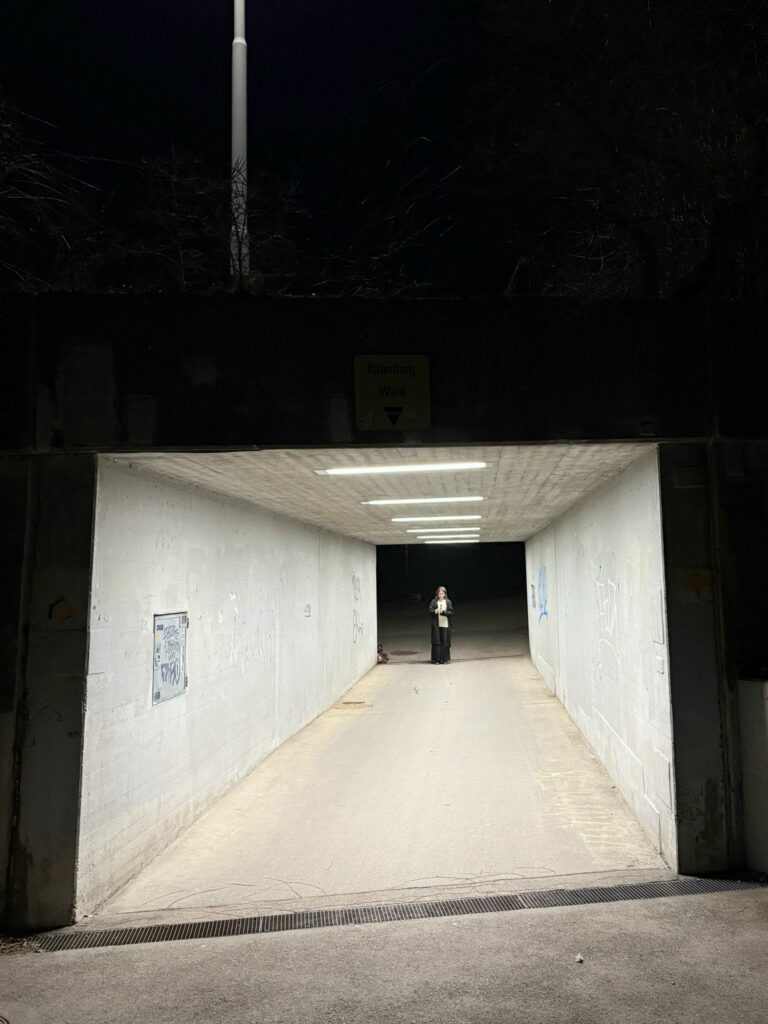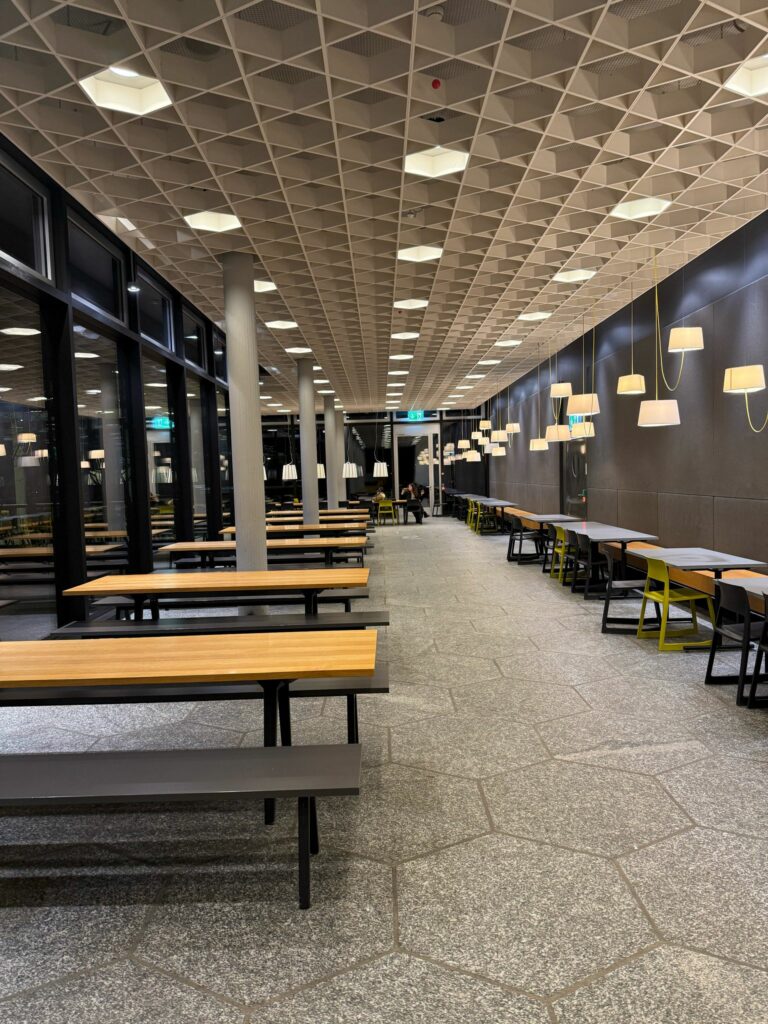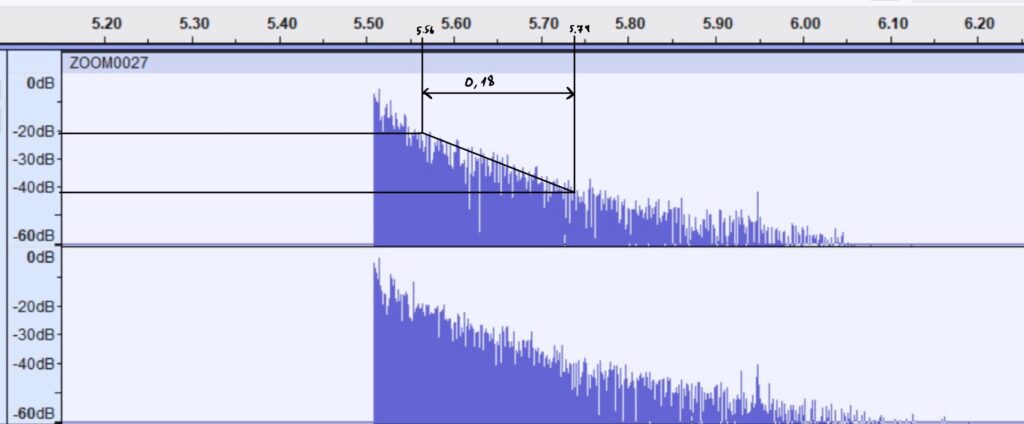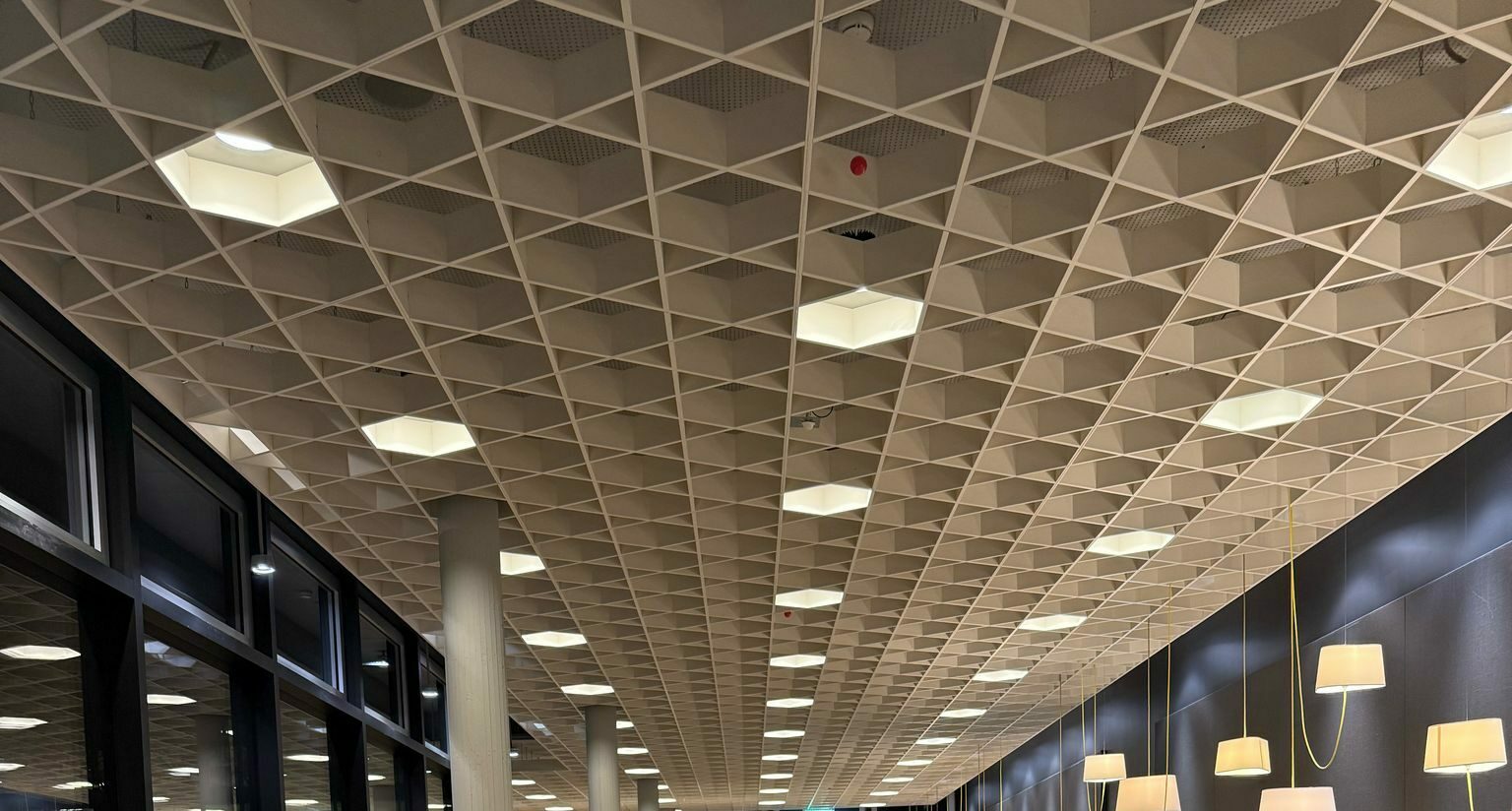The two places I visited were an underground tunnel, similar to the one we were in in Bern and the Food Market in HPH.

The primary function of the underground tunnel is to simply cross the road at a place where a crosswalk would disturb traffic. Because of that, it is a bare concrete space which creates a highly reflective environment. The sound in the tunnel was loud with a lot of reverb. The closer I was to the microphone the more one could hear the reverberation. Longer continuous sounds produced more reverb than shorter ones. Footsteps and voices were louder, echoing along the corridor. Sounds from passing vehicles were surprisingly loud. The space was cavernous and “boomy”.
Geometry-wise the space was a long narrow parallelepiped with smooth concrete surfaces. Because of that, the space acts as an echo chamber. Overall, it felt alive and echoey, making all sounds “boomy”.

In contrast, the Food Market in HPH is designed both for comfort and function. It is a space where students gather both to socialize and to study – two use cases which I thought wouldn’t fit well together in the same space. However, the open-plan design with tall ceilings makes sound dissipate quite easily, allowing for both functions. Even though you can hear noise from the people around you, you cannot easily make out what they are saying. In the recording sound gets quiet quickly once the speaker is behind you or further away from you. Sounds do not linger so even when the space is full it doesn’t feel overwhelming. Footsteps are fairly clear but disappear quickly.
The space feels a bit “dead” acoustically due to the minimal echoes despite the large open design. The part of the space which I recorded in also simplifies to a large parallelepiped despite the fact that the whole Food Market has more complex geometry. Sound was very clear in close proximity to the microphone.
2 Exploring the Emotional Impact of Everyday Sounds
Situation 1: Meierhofplatz
I went to the intersection on Meierhofplatz during the evening rush hour to listen to the sounds there. All sounds I heard were man made and were related to the traffic there – car engines, horns, bicycle bells and emergency vehicle sirens. There were also a lot of pedestrians talking. Emergency sirens and car horns stood out the most, while conversations often drew my attention. It felt a bit stressful and too loud. The sounds which were of higher frequency and/or higher volume were the most disturbing to me. Knowing that there was heavy traffic around I felt the need to stay alert of my surroundings. If I were to hear screeching of tires, I would become very alert. Loud shouting would have caused me discomfort.
Situation 2: The forest near the Hönggeberg campus
I went for a walk in the forest near the campus. Most of the sounds I heard were natural and involved bird songs, wind rustling the leaves and occasional movement of animals off the path. Sometimes I would hear man made sounds such as the steps of joggers on the path or quiet conversations. The chirping of birds dominated the soundscape. Their song was short, higher in frequency and volume and it drew my attention. At the same time, I would be drawn to man made sounds as they were quite rare. I felt relaxed in this environment. Nature sounds always calm me down and the man made sounds were quiet and rhythmic and thus felt pleasant. The forest itself reinforced the positive feelings. Sudden noises like shouting or unexpected animal noises would cause me to be alert and would be of discomfort to me.
3 Empirical and numerical estimation of room acoustic properties
Task 1
HPH
The estimated reverberation time was 0.54 seconds. I could not observe any echoes in the picture. The reverb time was measured by tripling the 20 dB drop.
- Decay Measured: Approx. 30 dB drop measured in 0.27 sec (×2 = 0.54 sec)
- Echoes Visible: No significant discrete echoes observed.

Tunnel
The estimated RT60 time was 2.64 seconds based on tripling the 20dB drop time. Echoes were clearly visible in the recording.

Task 2
The numerically estimated reverb time was quite different from my observations. I believe that this was because it was quite difficult to accurately describe my spaces using the presets of the software. Thus empirical values were better.
HPH
(Setting used was open plan office with similar dimensions)
- Calculated RT60 (500 Hz): 0.31
- Calculated RT60 (1000 Hz): 0.26
Tunnel
(Setting used was corridor with similar dimensions)
- Calculated RT60 (500 Hz): 2.13 seconds
- Calculated RT60 (1000 Hz): 2.18 seconds
4 Assembling all puzzle pieces
1. Underground Tunnel
The primary function of the underground tunnel is the pedestrian transit under a fairly busy road. It offers convenience both to the pedestrians and to the cars above. Its design prioritizes functionality and safety over comfort, and thus the acoustic properties of the space were not prioritized.
In this tunnel the empirical measurement of RT60 was 2.64 seconds which means that speech intelligibility would be low, however due to the fact that it is only a transition outdoor space this is not a serious issue. According to the DIN 18041 B1 category standard there is no need for absorbent features in this space.
No acoustic absorbers are present and the surfaces of the tunnel are very reflective – smooth concrete walls, ceiling and floor. Furthermore, the space is entirely empty and due to it being a long narrow parallelepiped there were significant flutter echoes.
Even though the space is not intended for communication it could be good to install porous absorbers on the ceiling and intermittently on the side wall from a weather resistant materials like perforated metal panels with mineral wool. Another option would be to put a porous coating on these walls like cementitious sprays.
2. Food Market in HPH
The space is a dual purpose space. It serves as a cafeteria and a study space. Because of that it should support both multiple conversations and individual concentration.
The empirical RT60 measurement of 0.54 seconds is within the recommended range for DIN 18041 (Category A3) and VDI 2569 for the intended use cases of the space.
The space is acoustically treated and the ceiling and walls are covered in porous absorbers. Furthermore the space is filled with furniture and lamps at different heights. This helps diffuse the sound in a way that makes the large space feel cozy and comfortable even when it is full of people. The floor is very acoustically reflective and so are the large windows but the treatment of the space makes up for that.
Because of all that I cannot recommend anything that would improve the acoustic properties of the space.
5 Final Assignment
Initial Room Assessment
The HIL B61 space is 7.3 m×11.6 m×2.8 m (≈237 m³) with all, except one, concrete floors, walls, and ceiling. Currently measured reverberation time (RT₆₀), is around 0.9-1.1s, which is much higher than the Swiss SIA and DIN18041 Group A guidelines require (RT₆₀ ≈0.48 s).
In other words, the room needs roughly double its present absorption to meet the guidelines. This would mean adding ~40–50 sabins of effective absorbing area (for example covering 60–80 m² of surface with high-α material). The mismatch is caused by the room’s all-hard and reflective surfaces.
Ceiling Treatments
For the ceiling I would suspend acoustic panels made of natural fiber. In particular, 40–50 mm thick hemp-flax panels (Ecoustic Bio Tile), which have very high mid-frequency absorption (Ecoustic hemp/flax α≈0.43 @250 Hz, 0.80 @500 Hz, 1.05 @1 kHz, NRC≈0.85). Covering 40 m² of the ceiling with such panels (≈50% area) would yield 25–30 sabins. These would break up the ceiling echo and absorb energy at speech frequencies. Hanging biophilic light fixtures with ferns could be integrated under the panels, which would add diffusion and mid-high absorption.

Wall Treatments
I would use Biophilic wall panels and green walls. The wall (≈32 m²) on the opposite side of the speaker could become a living green wall (pre-cultivated plants in felt substrate). Living wall systems achieve w_α ≈0.85 (weighted absorption) – absorbing ~85% of sound on average. A 32 m² green wall would add around 27 sabins. For the other walls, I would again install Ecoustic Bio Tiles with width of 40mm – Sahara Tiles for the walls and Airflake tiles where the windows are.


Floor Treatments
I would add a natural jute fiber carpet to lower mid-frequency reflections with around 20–30% coverage on the pathways around the desks. A 10–15 mm jute rug on concrete has α ≈ 0.1–0.2 at 250 Hz and α ≈ 0.3–0.4 at 1 kHz. Two large such rugs (if around 25 m²) at α = 0.3 would yield around 7–8 sabins.
Furniture and Fixtures
I would add acoustic partitions in the form of BuzziPlanter to “soak up” speech and HVAC noise, and to diffuse mid/high frequencies. A few such planters distributed around the desks in the room will add absorption of 0.5–1 sabins each.
Material Absorption Summary
| Element | Material (plant-based) | α (250–4000 Hz) | Notes / Sources |
|---|---|---|---|
| Ceiling | Hemp/flax composite (40–50 mm) | α≈0.43 (250 Hz), 0.80 (500 Hz), ≥1.05 (1 kHz) | NRC≈0.85 (Ecoustic Bio Tile) |
| Wall | Living green wall (plants+substrate) | α≈0.85 (weighted) | α_w=0.85, SAA/NRC≈0.87 |
| Windowless Walls | Hemp/flax composite (40–50 mm) | α≈0.43 (250 Hz), 0.80 (500 Hz), ≥1.05 (1 kHz) | NRC≈0.85 (Ecoustic Bio Tile Sahara) |
| Window Wall | Wood-wool (wood fiber) panel (25 mm) | α≈0.43 (250 Hz), 0.80 (500 Hz), ≥1.05 (1 kHz) | NRC≈0.25 (Ecoustic Bio Tile Airflake) |
| Floor | Jute carpet | α≈0.15–0.2 (250 Hz), ≈0.4 (1000 Hz) | Natural fiber area rug |
| Furniture | Acoustic planter (foam + plants) | α≈0.3 (250 Hz), ≈0.8 (2000 Hz) | Foam core + foliage |
RT₆₀ Calculations and Expected Improvement
Using Sabine’s formula the estimated RT₆₀ = 0.161·V/A. at V=237 m³ yields RT₆₀ ≈1.2–1.8 s before treatment. With the above interventions, a total additional absorption of around 80 sabins can be added. If this is realized an RT₆₀ ≈0.48 s can achieved which would match the requirements.
Justification of Materials and Effects
All proposed materials are renewable, low-VOC, and recyclable. Natural fibers have demonstrated acoustic absorption comparable to mineral wool. Those panels are non-toxic and with good durability. Live plants (green walls and planters) not only absorb sound (α_w~0.85) but also improve air quality and can contribute to the wellbeing of the room’s occupants.
One would need to ensure that the proposed panels comply with fire safety regulations. Furthermore hte pants near the desks would require irrigation and maintenance. Plants would need to be able to live underground with artificial light so ferns and pothos are suggested.
In summary, by combining natural-fiber panels, vegetated walls, fiber rugs, and acoustic furnishings, the space could be enhanced to meet the RT≈0.5 s requirements.



